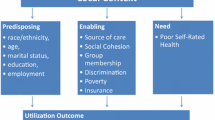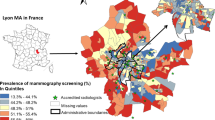Abstract
Objective
Despite its benefit, about 30% of women report that they did not have a recent mammogram. We examine impact of distance, rural–urban residence, and other characteristics on mammography screening rates.
Methods
We linked data on 33,938 women aged 40–84 years from the 2003 and 2005 California Health Interview Survey with FDA data on the location of mammography facilities in California, and with socioeconomic and geographic variables from the 2000 Census. We use logistic regression models to estimate the impact of selected variables on a woman’s probability of having had a recent mammogram and developed a new mapping scheme to help visualize differences in mammography use across California.
Results
Though distance to a facility did not impact a woman’s probability of having had a recent mammogram, women who resided in urban areas had somewhat higher screening rates than those living in more rural areas, as displayed on our map.
Conclusions
Our findings suggest that more research is needed on possible disparities in access to mammography between rural and non-rural areas in California. Therefore, data adequately powered to examine rural populations and to compare them with urban populations are needed.


Similar content being viewed by others
References
Shapiro S (1977) Evidence on screening for breast cancer from a randomized trial. Cancer 39(6 suppl):2772–2782. doi:10.1002/1097-0142(197706)39:6≤2772::AID-CNCR2820390665≥3.0.CO;2-K
Meissner HI, Breen N, Taubman ML, Vernon SW, Graubard BI (2007) Which women aren’t getting mammograms and why? (United States). Cancer Causes Control 18(1):61–70. doi:10.1007/s10552-006-0078-7
Hiatt RA, Klabunde C, Breen N, Swan J, Ballard-Barbash R (2002) Cancer screening practices from National Health Interview Surveys: past, present, and future. J Natl Cancer Inst 94(24):1837–1846
Swan J, Breen N, Coates RJ, Rimer BK, Lee NC (2003) Progress in cancer screening practices in the United States: results from the 2000 National Health Interview Survey. Cancer 97(6):1528–1540. doi:10.1002/cncr.11208
Breen N, Wagener DK, Brown ML, Davis WW, Ballard-Barbash R (2001) Progress in cancer screening over a decade: results of cancer screening from the 1987, 1992, and 1998 National Health Interview Surveys. J Natl Cancer Inst 93(22):1704–1713. doi:10.1093/jnci/93.22.1704
Rimer B, Meissner H, Breen N, Legler J, Coyne C (2001) Social and behavioral interventions to increase breast cancer screenings. In: Schneiderman N, Speers M, Silva J, Tomes H, Gentry J (eds) Integrating behavioral and social sciences with public health. American Psychological Association, Washington, DC, pp 177–201
Ward MM, Vaughn TE, Uden-Holman T et al (2002) Physician knowledge, attitudes and practices regarding a widely implemented guideline. J Eval Clin Pract 8(2):155–162. doi:10.1046/j.1365-2753.2002.00337.x
Mandelblatt JS, Yabroff KR (1999) Effectiveness of interventions designed to increase mammography use: a meta-analysis of provider-targeted strategies. Cancer Epidemiol Biomarkers Prev 8(9):759–767
Roetzheim RG, Fox SA, Leake B (1995) Physician-reported determinants of screening mammography in older women: the impact of physician and practice characteristics. J Am Geriatr Soc 43(12):1398–1402
Breen N, Meissner HI (2005) Toward a system of cancer screening in the United States: trends and opportunities. Annu Rev Public Health 26:561–582. doi:10.1146/annurev.publhealth.26.021304.144703
Legler J, Breen N, Meissner H, Malec D, Coyne C (2002) Predicting patterns of mammography use: a geographic perspective on national needs for intervention research. Health Serv Res 37(4):929–947. doi:10.1034/j.1600-0560.2002.59.x
Coughlin SS, Leadbetter S, Richards T, Sabatino SA (2008) Contextual analysis of breast and cervical cancer screening and factors associated with health care access among United States women, 2002. Soc Sci Med 66(2):260–275. doi:10.1016/j.socscimed.2007.09.009
Fortney JC, Booth BM, Blow FC, Bunn JY (1995) The effects of travel barriers and age on the utilization of alcoholism treatment aftercare. Am J Drug Alcohol Abuse 21(3):391–406. doi:10.3109/00952999509002705
Marcus SC, Fortney JC, Olfson M, Ryan ND (1997) Travel distance to outpatient treatment for depression. Psychiatr Serv 48(8):1005
Mayer JD (1983) The distance behavior of hospital patients: a disaggregated analysis. Soc Sci Med 17(12):819–827. doi:10.1016/0277-9536(83)90032-1
Brustrom JE, Hunter DC (2001) Going the distance: how far will women travel to undergo free mammography? Mil Med 166(4):347–349
Baines CJ, To T, Wall C (1990) Women’s attitudes to screening after participation in the National Breast Screening Study. A questionnaire survey. Cancer 65(7):1663–1669. doi:10.1002/1097-0142(19900401)65:7≤1663::AID-CNCR2820650735≥3.0.CO;2-A
Richardson A (1990) Factors likely to affect participation in mammographic screening. N Z Med J 103(887):155–156
Casey MM, Thiede Call K, Klingner JM (2001) Are rural residents less likely to obtain recommended preventive healthcare services? Am J Prev Med 21(3):182–188. doi:10.1016/S0749-3797(01)00349-X
Clarke PM (1998) Cost-benefit analysis and mammographic screening: a travel cost approach. J Health Econ 17(6):767–787. doi:10.1016/S0167-6296(98)00031-9
Monroe AC, Ricketts TC, Savitz LA (1992) Cancer in rural versus urban populations: a review. J Rural Health 8(3):212–220. doi:10.1111/j.1748-0361.1992.tb00354.x
Kreher NE, Hickner JM, MTt Ruffin, Lin CS (1995) Effect of distance and travel time on rural women’s compliance with screening mammography: an UPRNet study. Upper Peninsula Research Network. J Fam Pract 40(2):143–147
Engelman KK, Hawley DB, Gazaway R et al (2002) Impact of geographic barriers on the utilization of mammograms by older rural women. J Am Geriatr Soc 50(1):62–68. doi:10.1046/j.1532-5415.2002.50009.x
Hall HI, Uhler RJ, Coughlin SS, Miller DS (2002) Breast and cervical cancer screening among Appalachian women. Cancer Epidemiol Biomarkers Prev 11(1):137–142
Coughlin SS, Thompson TD, Hall HI, Logan P, Uhler RJ (2002) Breast and cervical carcinoma screening practices among women in rural and nonrural areas of the United States, 1998–1999. Cancer 94(11):2801–2812. doi:10.1002/cncr.10577
Nuworsoo C (2007) Defining sampling districts for household travel surveys: case study of the Baltimore, Maryland, Metropolitan Area. Transp Res Rec 2014:32–38. doi:10.3141/2014-05
Mobley LR, Kuo TM, Driscoll D, Clayton L, Anselin L (2008) Heterogeneity in mammography use across the nation: separating evidence of disparities from the disproportionate effects of geography. Int J Health Geogr 7(1):32. doi:10.1186/1476-072X-7-32
Barry J, Breen N (2005) The importance of place of residence in predicting late-stage diagnosis of breast or cervical cancer. Health Place 11(1):15–29. doi:10.1016/j.healthplace.2003.12.002
Gumpertz ML, Pickle LW, Miller BA, Bell BS (2006) Geographic patterns of advanced breast cancer in Los Angeles: associations with biological and sociodemographic factors (United States). Cancer Causes Control 17(3):325–339. doi:10.1007/s10552-005-0513-1
Zenk SN, Tarlov E, Sun J (2006) Spatial equity in facilities providing low- or no-fee screening mammography in Chicago neighborhoods. J Urban Health 83(2):195–210. doi:10.1007/s11524-005-9023-4
Barrett RE, Cho YI, Weaver KE et al (2008) Neighborhood change and distant metastasis at diagnosis of breast cancer. Ann Epidemiol 18(1):43–47. doi:10.1016/j.annepidem.2007.07.001
Medical Service Study Areas (2005) Population Center-Medical Service Study Area, MSSA 2000. California Office of Statewide Health Planning and Development
Survey California Health Interview (2005) CHIS 2003 methodology series: report 2—sample design. UCLA Center for Health Policy Research, Los Angeles
Survey California Health Interview (2007) CHIS 2005 methodology series: report 2—sample design. UCLA Center for Health Policy Research, Los Angeles
Survey California Health Interview (2007) CHIS 2005 methodology series: report 5—weighting and variance estimation. UCLA Center for Health Policy Research, Los Angeles
Survey California Health Interview (2005) CHIS 2003 methodology series: report 5—weighting and variance estimation. UCLA Center for Health Policy Research, Los Angeles
Lane DS (2000) A threat to the public health workforce: evidence from trends in preventive medicine certification and training. Am J Prev Med 18(1):87–96. doi:10.1016/S0749-3797(99)00111-7
Waitzman NJ, Smith KR (1998) Phantom of the area: poverty-area residence and mortality in the United States. Am J Public Health 88(6):973–976. doi:10.2105/AJPH.88.6.973
Diez Roux AV (2001) Investigating neighborhood and area effects on health. Am J Public Health 91(11):1783–1789
Research Triangle Institute (2004) SUDAAN language manual: release 9.0, 9th edn. Research Triangle Institute, Research Triangle Park, NC
Wolter K (1984) Introduction to variance estimation. Springer-Verlag, New York
Lee S, Davis W, Nguyen H et al. (2006) Examining trends and averages using combined cross-sectional survey data from multiple years. California Health Interview Survey. UCLA Center for Health Policy Research, Los Angeles
Moore DS, McCabe GP, Craig BA (2009) Introduction to the practice of statistics. W.H. Freeman and Company, New York
Rao RS, Graubard BI, Breen N, Gastwirth JL (2004) Understanding the factors underlying disparities in cancer screening rates using the Peters-Belson approach: results from the 1998 National Health Interview Survey. Med Care 42(8):789–800. doi:10.1097/01.mlr.0000132838.29236.7e
Nass S, Ball J (eds) (2005) Improving mammography quality standards. The National Academies Press, Washington, DC
Reynolds P, Hurley S, Goldberg DE et al (2004) Regional variations in breast cancer among california teachers. Epidemiology 15(6):746–754. doi:10.1097/01.ede.0000134863.45834.50
Anderson LM, May DS (1995) Has the use of cervical, breast, and colorectal cancer screening increased in the United States? Am J Public Health 85(6):840–842. doi:10.2105/AJPH.85.6.840
Breen N, Kessler L (1994) Changes in the use of screening mammography: evidence from the 1987 and 1990 National Health Interview Surveys. Am J Public Health 84(1):62–67. doi:10.2105/AJPH.84.1.62
Calle EE, Flanders WD, Thun MJ, Martin LM (1993) Demographic predictors of mammography and Pap smear screening in US women. Am J Public Health 83(1):53–60
Zhang P, Tao G, Irwin KL (2000) Utilization of preventive medical services in the United States: a comparison between rural and urban populations. J Rural Health 16(4):349–356. doi:10.1111/j.1748-0361.2000.tb00485.x
Survey California Health Interview (2005) CHIS 2003 methodology series: report 4—response rates. UCLA Center for Health Policy Research, Los Angleles
Survey California Health Interview (2007) CHIS 2005 methodology series: report 4—response rates, 1st edn. UCLA Center for Health Policy Research, Los Angeles
Curtin R, Presser S, Singer E (2005) Changes in telephone survey nonresponse over the past quarter century. Public Opinion Quarterly 69:87–98. doi:10.1093/poq/nfi002
Groves R (2006) Nonresponse rates and nonresponse bias in household surveys. Public Opin Q 70:646–675. doi:10.1093/poq/nfl033
Survey California Health Interview (2003) CHIS technical paper no. 1—the CHIS 2001 sample: response rate and representativeness. UCLA Center for Health Policy Research, Los Angeles
Survey California Health Interview (2007) CHIS 2005 methodology series: report 1—sample design. UCLA Center for Health Policy Research, Los Angeles
Blumberg SJ, Luke JV, Cynamon ML (2006) Telephone coverage and health survey estimates: evaluating the need for concern about wireless substitution. Am J Public Health 96(5):926–931. doi:10.2105/AJPH.2004.057885
Skaer TL, Robison LM, Sclar DA, Harding GH (1996) Financial incentive and the use of mammography among Hispanic migrants to the United States. Health Care Women Int 17(4):281–291
Acknowledgments
We thank Dr. Eric “Rocky” Feuer and Dr. Martin Brown for their review during the preparation of this manuscript. We are grateful to Brandon Traudt and Dr. David Grant for linking the CHIS data to socioeconomic and geographic variables from the 2000 Census data. We thank the anonymous reviewers for their helpful comments. Financial support was provided to Dr. Monica Jackson by the Statistical Research and Applications Branch of the National Cancer Institute as part of contract number 263-MQ-706620 and the Intergovernmental Personnel Act (IPA).
Author information
Authors and Affiliations
Corresponding author
Additional information
All works were performed at the National Cancer Institute and American University.
Rights and permissions
About this article
Cite this article
Jackson, M.C., Davis, W.W., Waldron, W. et al. Impact of geography on mammography use in California. Cancer Causes Control 20, 1339–1353 (2009). https://doi.org/10.1007/s10552-009-9355-6
Received:
Accepted:
Published:
Issue Date:
DOI: https://doi.org/10.1007/s10552-009-9355-6




